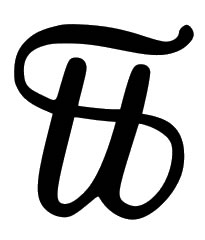What do you call the symbol #?
I would call it a hash or hashtag, but quite a few other names are available, including number, number sign, number mark, pound sign, hash sign, hash mark, crosshatch, crunch, fence, flash, garden fence, garden gate, gate, grid, hak, hex, mesh, octothorp, oof, pig-pen, punch mark, rake, scratch, scratch mark, tic-tac-toe and unequal.

It is thought that it comes from the symbol ℔, a ligature of l and b which stands for the Latin libra pondo (pound weight). Over time it became simplified until it morphed into #. The image is a stylized version of this symbol [source].
# is described as “number” in a treatise on bookkeeping from 1853. It was included the Remington Standard typewriter keyboard from about 1886, and was used in teleprinter codes. In 1968 it was included on touch-tone telephone keypads, and started to be used more extensively in the early 1980s. It was used to label groups and topics on internet relay chat (IRC) from about 1988. This lead Chris Messina, an American blogger and consultant, to propose its use to tag topics on Twitter in 2007. He became known as the inventor of the hashtag [source].
The name octothorp, which was apparently invented at Bell Telephone Laboratories in 1968. Variants include octothorpe, octathorp and octatherp. The name combines octo- (eight) from Latin, with the English thorp (hamlet, village), as it looks like a village surrounded by eight fields. Other stories about the origins of this name are available.
Sources and further information:
https://en.wikipedia.org/wiki/Number_sign
https://www.sporcle.com/blog/2017/08/octothorpe-history/
https://www.dictionary.com/e/octothorpe/
Among Unix-style hackers, it has the fairly-standardized pronunciation of “pound”. This goes along with the standardized monosyllabic pronunciations of
! = bang
/ = slash
\ = whack.
I imagine this causes tons of trouble for UK hackers, as # is Shift-3 on U.S. keyboards, but I believe Shift-3 yields “£” in the UK, which is also pronounced “pound”.
When I started some simple programming around 1968, the # symbol on the teletype we used was called “pound sign”. Why? Because that’s what everyone called it (well, here in Michigan, that is). On through my IBM mainframe days and into PC’s, everybody but everybody called it a pound sign. Now with # being used so extensively on the Internet, I have relented – a LITTLE – and on rare occasions I will let “hash” slip through. But, in my heart of hearts, it’s a pound sign.
I find it interesting that, when looking at international keyboard layouts, there are characters commonly seen on the “3” key almost everywhere:
# (“pound” sign)
£ (“pound” currency)
№ (“number” or “Numero” sign)
So it would seem that a lot of people equate both # and £ as “pound”.
Jonathan,
It’s surprising how one could just assume the names for things and imagine everyone else thinks the same way. I always thought of / as “slash”, but I have heard UK people refer to / as a “stroke”. It turns out that in Unicode, this is a problem, because their names for letters are not at all consistent.
For instance, Ƚ is “L with Bar” but Ɨ is “I with Stroke”. But then, Ł is “L with Stroke” and Ⱦ is “T with Diagonal Stroke”. And what about a plain / symbol? Not a “slash” OR a “stroke”, but a “solidus”. SOLIDUS? Really? I’ve been working on keyboard design for years, and I still don’t know what the **** a “solidus” is.
P.S. I am familiar with ! being referred to as “bang”, and when a script starts with #!something, programmers will say “hash bang”.
But, \ being “whack” ?? Nope. Never. I think you’re pulling my leg on that one.
Robert: A ‘solidus’ was a Roman unit of currency, a gold coin used in the later Empire. In the old British pre-decimal currency, a ‘slash’, ‘stroke’ or ‘solidus’ was used to indicate ‘shilling’ (one-twentieth of a pound), thus: 3/- (three shillings), 2/6 (two shillings and six pence). ‘Solidus’ is also the origin of the old French coin ‘sou’ – originally ‘sol’ (one-twentieth of a livre) and lived on after decimalization ion France as an informal name for five centimes.
Shenn, thanks for your explanation of Solidus. These are details I hadn’t heard before.
I think the UK would have gone on forever with pounds, shillings and pence if it weren’t for computers. It turns out that formatting the old British currency on a computer for financial reports was very difficult, time-consuming and error-prone in terms of the programming effort required. I am certain that UK programmers shouted a collective sigh of relief when the currency went to decimal notation. It’s just SO much easier to do.